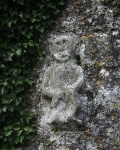Although this journey started almost four years ago with a chance encounter in a cliff-top field that subconsciously planted a seed, this is where that seed germinated into the idea for a blog and so the story begins…
After days of incessant rain of almost biblical proportions, a sunny Saturday afternoon presented a chance to exorcise the cabin fever, dust off the camera and go for a wander. I struck out from Peel, heading north unsure where I would end up, but thinking of coast and sea.
Passing Lynague beach I remembered just that morning having seen an old picture of the (now derelict) railway viaduct at Glen Mooar, which in turn reminded me of the shameful fact that I had never been to the adjacent Spooyt vane (white spout in Manx Gaelic) waterfall and given the recent deluge I thought it might be an especially worthy muse for my camera.
Five minutes later and I was slipping and stumbling up a clay and mud track carved out through the mossy understorey of a most typical Manx glen clad in ferns and fuchsia. The track meandered in sympathy but not in sync with the still invisible river and the sound of rushing water ebbed and flowed. Not knowing the location of the waterfall I kept a keen ear on the river, expecting to hear the roar of the falls as I approached.
Up ahead I caught sight of what appeared to be the ruins of an old tholtan in a glade in the woods. Once the path was level with the building an old metal sign at the base of a tree indicated that the building, which was probably no larger than an average garage was Cabbal Pherick, or St Patricks chapel dating back to the 8-10th century.
I stepped over the low wall luxuriant in mosses, onto consecrated ground and across the old church yard which was studded with the barely visible remains of slate gravestones, like the stumps of broken teeth in the mouth of a fallen giant.

Apart from the fading memory of a graveyard, little remained of the building to indicate its ecclesiastical origins. The sign informed that a crudely carved slate cross had been removed for safekeeping to nearby Kirk Michael churchyard.

There was something enchanting about sitting in the glade. Perhaps it was the rare glimpse of the sun through the dappled shade of the overhanging ash trees, or the suddenly noticeable roar of the waterfall, still distant enough to provide little competition for the melancholy trill of a watchful robin. The ghosts of medieval monks and the souls of the deceased were a distant thought.
 Stirring myself from the stillness of the churchyard I continued to slide up the track following the sound of the waterfall. A short distance later I arrived at the top of a steep flight of muddy steps carved into the steep glen and cloaked in greenery. Halfway down the sodden steps the might Spooyt vane came into view, a two-tiered behemoth in full, furious flow.
Stirring myself from the stillness of the churchyard I continued to slide up the track following the sound of the waterfall. A short distance later I arrived at the top of a steep flight of muddy steps carved into the steep glen and cloaked in greenery. Halfway down the sodden steps the might Spooyt vane came into view, a two-tiered behemoth in full, furious flow.

Descending to the bottom of the steps revealed its full splendour. Spray danced across the rocks, erupting in mini-rainbows and the water bubbled and eddied in the plunge pool at the foot of the falls.

The white-noise roar of the cascading water in the narrow, emerald-encrusted rock amphitheatre excluded all other sounds and it struck me that such a place, in addition to providing a most practical source of clean water must have been endowed with spiritual properties by the founders of the nearby church and most likely the pagan Celts and Vikings that preceded them. I stayed there for a long while watching the cascading water slip quickly away towards the awaiting sea in a Sisyphean pursuit that would see it one day return to fall as rain, refreshed and pure to cascade another waterfall.
Post script
Perhaps the notion of the waterfall as an auspicious addition to an ecclesiastical site was a little wide of the mark…
from http://www.isleofman.com/heritage/ePedia/History/Sites/keeills/spooytVane.aspx
“It is told of this Keeill that the last Priest who officiated in it was guilty of mending his carranes on a Sunday, and in consequence, met with a sudden and dreadful end. The story as told by the late Mr. Cannell was as follows: “The priest of Cabbal Pherick, at the Spooyt Vane, was a cobbler to his trade. One day he was so busy mending a pair of shoes that he did not notice the people passing in the road and looking at him in surprise. His housekeeper came to him at last and said ‘Are you not ashamed to be doing work on the Sabbath and all the people waiting at the Chapel for you.’ What are thou talking of woman,’ he said, ‘Go and count the eggs and see how many are in the nest.’ For the priest had a hen which laid an egg every day and they were collected only once a week, and that is how he knew what day it would be. So the woman went, and when she came back she said-Seven eggs there are.’ Then the priest threw down his tools, and rushed away with such haste that he fell down the Spooyt Vane, and was drowned. And the people never used the Chapel any more.” Another version lays stress on the fact that he waxed his shoe-laces, and when he was crossing the stream he tripped ever them and was carried down the fall !”



